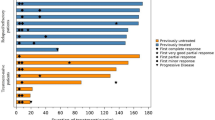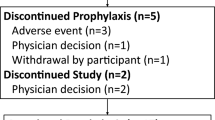Abstract
Objective
The aim of this meta-analysis was to evaluate the efficacy of basiliximab versus antithymocyte globulin for induction therapy in renal allograft.
Methods
Medline (PubMed), Embase, Ovid, Cochrane, and the Chinese Biomedical Literature databases were searched to identify prospective randomized controlled trials that compared basiliximab with antithymocyte globulin (ATG) for induction therapy in renal transplantation. RevMan 5.1 software and Stat Manager V4.1 software were used for the meta-analysis.
Results
Eight RCTs were included, including a total of 1153 patients. Of these, 547 (47%) had received basiliximab, and 606 (53%) had received ATG. The pooled results revealed that the basiliximab had a lower rate of neoplasm compared with ATG [odds ratio (OR) 0.26; 95% confidence interval (CI) 0.08–0.78; P = 0.02]. There were no significant differences between the two drugs regarding 1-year acute rejection rate (OR 1.32; 95% CI 0.93–1.87; P = 0.13), 1-year graft survival rate (OR 0.73; 95% CI 0.45–1.18; P = 0.20), 1-year patient survival rate (OR 0.52; 95% CI 0.27–1.02; P = 0.06), 1-year infection rate (OR 0.90; 95% CI 0.48–1.68; P = 0.73).
Conclusion
Induction therapy of basiliximab has similar short-time effects on the recipients in renal transplantation compared with that of ATG. However, regarding the long-term effect, as represented by the rate of neoplasm, basiliximab has a significant advantage.






Similar content being viewed by others
References
Mourad G, Rostaing L, Legendre C, Garrigue V, Thervet E, Durand D. Sequential protocols using basiliximab versus antithymocyte globulins in renal-transplant patients receiving mycophenolate mofetil and steroids. Transplantation. 2004;78(4):584.
Sheashaa HA, Bakr MA, Ismail AM, Gheith OE, El-dahshan KF, Sobh MA, et al. Long-term evaluation of basiliximab induction therapy in live donor kidney transplantation: a 5-year prospective randomized study. Am J Nephrol. 2005;25(3):221.
Nashan B. Antibody induction therapy in renal transplant patients receiving calcineurin-inhibitor immunosuppressive regimens: a comparative review. BioDrugs Clin Immunother Biopharm Gene Ther. 2005;19(1):39.
Bunnapradist S, Takemoto SK. Multivariate analysis of antibody induction therapy and their associated outcomes in deceased donor transplants. Transpl Proc. 2005;37(2):889.
Bouvy AP, Klepper M, Kho MM, Boer K, Betjes MG, Weimar W, et al. The impact of induction therapy on the homeostasis and function of regulatory T cells in kidney transplant patients. Nephrol Dial Transplant Off Publ Eur Dial Transpl Assoc Eur Ren Assoc. 2014;29(8):1587.
Todeschini M, Cortinovis M, Perico N, Poli F, Innocente A, Cavinato RA, et al. In kidney transplant patients, alemtuzumab but not basiliximab/low-dose rabbit anti-thymocyte globulin induces B cell depletion and regeneration, which associates with a high incidence of de novo donor-specific anti-HLA antibody development. J Immunol. 2013;191(5):2818.
Zhao T, Yang C, Xue Y, Qiu YY, Hu L, Qiu Y, et al. Impact of basiliximab on the proportion of regulatory T cells and their subsets early after renal transplantation: a preliminary report. Transpl Proc. 2012;44(1):175.
Clarke M, Horton R. Bringing it all together: Lancet-Cochrane collaborate on systematic reviews. Lancet. 2001;357(9270):1728.
Stroup DF, Berlin JA, Morton SC, Olkin I, Williamson GD, Rennie D, et al. Meta-analysis of observational studies in epidemiology: a proposal for reporting. Meta-analysis of observational studies in epidemiology (MOOSE) group. JAMA. 2000;283(15):2008.
DerSimonian R, Laird N. Meta-analysis in clinical trials. Control Clin Trials. 1986;7(3):177.
Meng F, Chen S, Guo X, Chen Z, Huang X, Lai Y, et al. Clinical significance of myeloid-derived suppressor cells in human renal transplantation with acute T cell-mediated rejection. Inflammation. 2014;37(5):1799–805.
Eid L, Tuchman S, Moudgil A. Late acute rejection: incidence, risk factors, and effect on graft survival and function. Pediatr Transplant. 2014;18(2):155.
Gundlapalli S, Rathi M, Kohli HS, Jha V, Sharma A, Minz M, et al. Efficacy of basiliximab induction in poorly matched living donor renal transplantation. Indian J Nephrol. 2013;23(6):409.
Kesiraju S, Paritala P, Rao Ch UM, Athmakuri SM, Reddy VS, Sahariah S. Anti-thymocyte globulin versus basiliximab induction in renal transplant recipients: long-term outcome. Saudi J Kidney Dis Transplant Off Publ Saudi Cent Organ Transplant Saudi Arab. 2014;25(1):9.
Zukowski M, Kotfis K, Biernawska J, Zegan-Baranska M, Kaczmarczyk M, Ciechanowicz A, et al. Graft infection in kidney recipients and its relation to transplanted kidney function. Transpl Proc. 2011;43(8):2997.
Tuuminen R, Nykanen AI, Saharinen P, Gautam P, Keranen MA, Arnaudova R, et al. Donor simvastatin treatment prevents ischemia-reperfusion and acute kidney injury by preserving microvascular barrier function. Am J Transplant Off J Am Soc Transplant Am Soc Transpl Surg. 2013;13(8):2019.
Horowitz N, Oren I, Lavi N, Zuckerman T, Benyamini N, Kra-Oz Z, et al. New rising infection: human herpesvirus 6 is frequent in myeloma patients undergoing autologous stem cell transplantation after induction therapy with bortezomib. Bone Marrow Res. 2012;2012:409765.
Galindo Sacristan P, Perez Marfil A, Osorio Moratalla JM, de Gracia Guindo C, Ruiz Fuentes C, Castilla Barbosa YA, et al. Predictive factors of infection in the first year after kidney transplantation. Transpl Proc. 2013;45(10):3620.
Martinez-Vaquera S, Navarro Cabello MD, Lopez-Andreu M, Jurado JM, Haad CR, Salas RO, et al. Outcomes in renal transplantation with expanded-criteria donors. Transpl Proc. 2013;45(10):3595.
Harzallah K, Abderrahim E, Chareffedine K, Yeich S, Belhadj R, Skhiri H, et al. Cancers after renal transplantation: multicenter experience. Saudi J Kidney Dis Transplant Off Publ Saudi Cent Organ Transplant Saudi Arab. 2008;19(5):825.
Cantarovich M, Durrbach A, Hiesse C, Ladouceur M, Benoit G, Charpentier B. 20-year follow-up results of a randomized controlled trial comparing antilymphocyte globulin induction to no induction in renal transplant patients. Transplantation. 2008;86(12):1732.
Schmidt-Hieber M, Fietz T, Knauf W, Uharek L, Hopfenmuller W, Thiel E, et al. Efficacy of the interleukin-2 receptor antagonist basiliximab in steroid-refractory acute graft-versus-host disease. Br J Haematol. 2005;130(4):568.
Al Najjar A, Etienne I, Le Pogamp P, Bridoux F, Le Meur Y, Toupance O, et al. Long-term results of monoclonal anti-Il2-receptor antibody versus polyclonal antilymphocyte antibodies as induction therapy in renal transplantation. Transplant Proc. 2006;38(7):2298.
Tullius SG, Pratschke J, Strobelt V, Kahl A, Reinke P, May G, et al. ATG versus basiliximab induction therapy in renal allograft recipients receiving a dual immunosuppressive regimen: one-year results. Transplant Proc. 2003;35(6):2100.
Pilch NA, Taber DJ, Moussa O, Thomas B, Denmark S, Meadows HB, et al. Prospective randomized controlled trial of rabbit antithymocyte globulin compared with IL-2 receptor antagonist induction therapy in kidney transplantation. Ann Surg. 2014;259(5):888.
Sollinger H, Kaplan B, Pescovitz MD, Philosophe B, Roza A, Brayman K, et al. Basiliximab versus antithymocyte globulin for prevention of acute renal allograft rejection. Transplantation. 2001;72(12):1915.
Kyllonen LE, Eklund BH, Pesonen EJ, Salmela KT. Single bolus antithymocyte globulin versus basiliximab induction in kidney transplantation with cyclosporine triple immunosuppression: efficacy and safety. Transplantation. 2007;84(1):75.
Brennan DC, Daller JA, Lake KD, Cibrik D, Del Castillo D, Thymoglobulin Induction Study G. Rabbit antithymocyte globulin versus basiliximab in renal transplantation. N Engl J Med. 2006;355(19):1967.
Patel HV, Kute VB, Vanikar AV, Shah PR, Gumber MR, Engineer DP, et al. Low-dose rabbit anti-thymoglobin globulin versus basiliximab for induction therapy in kidney transplantation. Saudi J Kidney Dis Transpl. 2014;25(4):819.
Author information
Authors and Affiliations
Corresponding author
Ethics declarations
Conflict of interest
The authors have declared that no conflict of interest exists.
Human and animal rights statement
This article does not contain any studies with human participants performed by any of the authors.
Informed consent
Informed consent was obtained from all individual participants included in the study.
About this article
Cite this article
Wang, K., Xu, X. & Fan, M. Induction therapy of basiliximab versus antithymocyte globulin in renal allograft: a systematic review and meta-analysis. Clin Exp Nephrol 22, 684–693 (2018). https://doi.org/10.1007/s10157-017-1480-z
Received:
Accepted:
Published:
Issue Date:
DOI: https://doi.org/10.1007/s10157-017-1480-z




